Electromagnetic Shielding Performance of Carbon Black Mixed Concrete with Zn–Al Metal Thermal Spray Coating
Abstract
1. Introduction
2. Materials and Methods
2.1. Experiment Overview
2.2. Materials and Concrete Mixing
2.3. Specimen Fabrication and Curing Methods
2.4. Characterization of Zn–Al Coating
2.5. Electromagnetic Shielding Performance Evaluation Using Waveguide
3. Results and Discussion
3.1. Concrete Material Characteristics
3.2. SEM and XRD of Zn–Al Coating
3.3. Evaluation of Electromagnetic Wave Shielding Performance of the Concrete
3.4. Shielding Effectiveness of Specimen without Zn–Al Coating at Different Studied Frequency
3.5. Evaluation of Electromagnetic Shielding Performance of Zn–Al Metal Thermal Spray Coating
3.6. Shielding Effectiveness of Specimen with Zn–Al Coating at Different Studied Frequency
4. Conclusions
Author Contributions
Funding
Acknowledgments
Conflicts of Interest
References
- Cho, G.; Cheon, J. Study on defense measure of EMP of nuclear and electromagnetic pulse weapon. DefenseTech 2007, 345, 52–59. (In Korean) [Google Scholar]
- IEC 61000-2-9. Electromagnetic Compatibility (EMC)—Part 2: Environment—Section 9: Description of HEMP Environment–Radiated Disturbance; International Electrotechnical Commission: Geneva, Switzerland, 1996; p. 49. [Google Scholar]
- Jacob, G. The Swiss EMP Concept of General Defense. IEEE Antennas Propag. Soc. Newsl. 1987, 29, 5–10. [Google Scholar]
- Kim, H.S. Truth of EMP threat and development plan. DefenceTech 2013, 414, 98–103. (In Korean) [Google Scholar]
- Choi, T.; Cho, W. Countermeasure of Electromagnetic Pulse (EMP). DefenseTech 1992, 157, 54–59. (In Korean) [Google Scholar]
- Savage, E.; Gilbert, J.; Radasky, W. The Early-Time (E1) High-Altitude Electromagnetic Pulse (HEMP) and Its Impact on the U.S. Power Grid; Metatech Report; Metatech Corporation: Goleta, CA, USA, 2010; p. 168. [Google Scholar]
- Gurevich, V. Protection of Substation Critical Equipment against Intentional Electromagnetic Threats; Wiley: London, UK, 2017; p. 240. [Google Scholar]
- Foster, J.S.; Gjelde, E.; Graham, W.R.; Hermann, R.J.; Kluepfel, H.M.; Lawson, R.L.; Soper, G.K.; Wood, L.L.; Woodard, J.B. Report of the Commission to Assess the Threat to the United States from Electromagnetic Pulse (EMP) Attack Critical National Infrastructures; Electromagnetic Pulse (EMP) Commission: Mclean, VA, USA, 2008; p. 208. [Google Scholar]
- Department of Defense. MIL-STD-188-125-1. High-Altitude Electromagnetic Pulse (HEMP) Protection for Ground-Based C4I Facilities Performing Critical, Time-Urgent Missions Part 1 Fixed Facilities; Department of Defense Interface Standard; Department of Defense: Arlington, VA, USA, 17 July 1998; p. 106.
- IEEE-299. IEEE Standard Method for Measuring the Effectiveness of Electromagnetic Shielding Enclosures; IEEE Standards Association: Piscataway, NJ, USA, 2006; p. 50. [Google Scholar]
- TAI, M.F.; KOK, S.L.; MUKAI, K. EMI Shielding Performance by Metal Plating on Mold Compound, 37th International Electronics Manufacturing Technology (IEMT) Conference. Available online: https://ieeexplore.ieee.org/stamp/stamp.jsp?arnumber=7761978 (accessed on 8 August 2019).
- Chung, D.D.L. Electromagnetic interference shielding effectiveness of carbon materials. Carbon 2001, 39, 279–285. [Google Scholar] [CrossRef]
- Lee, J.K.; Kim, J.H.; Kim, H.K.; Lee, H.B. Research on the Spectrum of Electromagnetic Wave Emission. Final report: Radio Research Laboratory; Harvard University: Cambridge, MA, USA, 2003; p. 325. [Google Scholar]
- Lee, H.S.; Choe, H.B.; Baek, I.Y.; Singh, J.K.; Ismail, M.A. Study on the Shielding Effectiveness of an Arc Thermal Metal Spraying Method against an Electromagnetic Pulse. Materials 2017, 10, 1155. [Google Scholar] [CrossRef]
- Nenghong, X.; Xueqin, Y.; Wenwu, S. Shielding effectiveness and coupling characteristic of metallic enclosures with apertures under EMP. In Proceedings of the 2009 Asia-Pacific Power and Energy Engineering Conference (APPEEC 2009), Wuhan, China, 27–31 March 2009; pp. 1–4. Available online: http://ieeexplore.ieee.org/stamp/stamp.jsp?arnumber=4918742 (accessed on 25 June 2017).
- Cheng, G.; Bihua, Z.; Bin, C.; Yun, Y.; Yanxin, L. The penetrating of EMP fields into a metal shielding enclosure by a slot. In Proceedings of the 2002 3rd International Symposium on Electromagnetic Compatibility, Beijing, China, 21–24 May 2002; pp. 127–130. Available online: http://ieeexplore.ieee.org/stamp/stamp.jsp?arnumber=1177382 (accessed on 1 July 2017).
- Nam, I.W.; Kim, H.K.; Lee, H.K. Influence of silica fume additions on electromagnetic interference shielding effectiveness of multi-walled carbon nanotube/cement composites. Constr. Build. Mater. 2012, 30, 480–487. [Google Scholar] [CrossRef]
- Kim, H.K.; Nam, I.W.; Lee, H.K. Enhanced effect of carbon nanotube on mechanical and electrical properties of cement composites by incorporation of silica fume. Compo. Struct. 2014, 107, 60–69. [Google Scholar] [CrossRef]
- Khushnood, R.A.; Ahmad, S.; Savi, P.; Tulliani, J.M.; Giorcelli, M.; Ferro, G.A. Improvement in electromagnetic interference shielding effectiveness of cement composites using carbonaceous nano/micro inerts. Constr. Build. Mater. 2015, 85, 208–216. [Google Scholar] [CrossRef]
- Cao, J.; Chung, D.D.L. Colloidal graphite as an admixture in cement and as a coating on cement for electromagnetic interference shielding. Cem. Concr. Res. 2003, 33, 1737–1740. [Google Scholar] [CrossRef]
- Wu, J.; Chung, D.D.L. Improving colloidal graphite for electromagnetic interference shielding using 0.1 lm diameter carbon filaments. Carbon 2003, 41, 1313–1315. [Google Scholar] [CrossRef]
- Chung, D.D.L. Exfoliation of graphite. J. Mater. Sci. 1987, 22, 4190–4198. [Google Scholar] [CrossRef]
- Chung, D.D.L. Review graphite. J. Mat. Sci. 2002, 37, 1475–1489. [Google Scholar] [CrossRef]
- Luo, X.; Chung, D.D.L. Electromagnetic interference shielding reaching 130 dB using flexible graphite. Carbon 1996, 34, 1293–1294. [Google Scholar] [CrossRef]
- Kim, Y.J.; Yeman, D.M.; Kim, B.J.; Yi, C.K. Effect of fiber geometry on the electromagnetic shielding performance of mortar. Comput. Concr. 2016, 17, 281–294. [Google Scholar] [CrossRef]
- Wen, S.; Chung, D.D.L. Electromagnetic interference shielding reaching 70 dB in steel fiber cement. Cem. Concr. Res. 2004, 34, 329–332. [Google Scholar] [CrossRef]
- Tailor, S.; Modi, A.; Modi, S.C. Synthesis, microstructural, corrosion and antimicrobial properties of Zn and Zn–Al coatings. Surf. Eng. 2019, 35, 736–742. [Google Scholar] [CrossRef]
- Lee, H.-S.; Singh, J.K.; Ismail, M.A.; Bhattacharya, C.; Seikh, A.H.; Alharthi, N.; Hussain, R.R. Corrosion mechanism and kinetics of Al-Zn coating deposited by arc thermal spraying process in saline solution at prolong exposure periods. Sci. Rep. 2019, 9, 3399. [Google Scholar] [CrossRef]
- Lee, H.S.; Park, J.H.; Singh, J.K.; Ismail, M.A. Protection of reinforced concrete structures of waste water treatment reservoirs with stainless steel coating using arc thermal spraying technique in acidified water. Materials 2016, 9, 753. [Google Scholar] [CrossRef]
- Lee, H.S.; Singh, J.K. Influence of calcium nitrate on morphology and corrosion characteristics of ammonium phosphate treated Aluminum coating deposited by arc thermal spraying process. Corros. Sci. 2019, 146, 254–268. [Google Scholar] [CrossRef]
- Lee, H.-S.; Park, J.-h.; Singh, J.K.; Ismail, M.A. Deposition of coating to protect waste water reservoir in acidic solution by arc thermal spray process. Adv. Mater. Sci. Eng. 2018, 1–13. [Google Scholar] [CrossRef]
- Lee, H.-S.; Kwon, S.-J.; Singh, J.K.; Ismail, M.A. Influence of Zn and Mg alloying on the corrosion resistance properties of Al coating applied by arc thermal spray process in simulated weather solution. Acta Met. Sin. (Eng. Lett.) 2018, 31, 591–603. [Google Scholar] [CrossRef]
- Park, J.-H.; Singh, J.K.; Lee, H.S. Ozone resistance, water permeability, and concrete adhesion of metallic films sprayed on a concrete structure for advanced water purification. Coatings 2017, 7, 41. [Google Scholar] [CrossRef]
- Lee, H.S.; Singh, J.K.; Ismail, M.A. An effective and novel pore sealing agent to enhance the corrosion resistance performance of Al coating in artificial ocean water. Sci. Rep. 2017, 7, 41935. [Google Scholar] [CrossRef]
- Lee, H.S.; Singh, J.K.; Park, J.H. Pore blocking characteristics of corrosion products formed on Aluminum coating produced by arc thermal metal spray process in 3.5 wt.% NaCl solution. Constr. Build. Mater. 2016, 113, 905–916. [Google Scholar] [CrossRef]
- Lee, H.S.; Singh, J.K.; Ismail, M.A.; Bhattacharya, C. Corrosion resistance properties of Aluminum coating applied by arc thermal metal spray in SAE J2334 solution with exposure periods. Metals 2016, 6, 55. [Google Scholar] [CrossRef]
- Choe, H.B.; Lee, H.S.; Shin, J.H. Experimental study on the electrochemical anti-corrosion properties of steel structures applying the arc thermal metal spraying method. Materials 2014, 7, 7722–7736. [Google Scholar] [CrossRef]
- KS F 2405. Standard Test Method for Compressive Strength of Concrete; Korea Standard: Seoul, Korea, 2017; p. 12. [Google Scholar]
- KS L 5201. Portland Cement; Korea Standard: Seoul, Korea, 2016; p. 16. [Google Scholar]
- KS F 2403. Standard Test Method for Making and Curing Concrete Specimens; Korea Standard: Seoul, Korea, 2014; p. 14. [Google Scholar]
- ASTM D 4935-10. Standard Test Method for Measuring the Electromagnetic Shielding Effectiveness of Planar Materials; American Society of Testing Materials: West Conshohocken, PA, USA, 2010; p. 11. [Google Scholar]
- Choi, H.J.; Park, J.H.; Min, T.B.; Jang, H.O.; Lee, H.S. An Experimental Study on the Evaluation of EMP Shielding Performance of Concrete Applied with ATMSM Using Zn-Al Alloy Wire. J. Korea Inst. Build. Constr. 2019, 19, 209–217. [Google Scholar]
- Chung, Y.C.; Kang, T.W.; Chung, N.S. Electromagnetic shielding effectiveness of the composite materials in the far field region. Proc. Korea Electromagne. Eng. Soc. 1994, 5, 31–39. [Google Scholar]
- Das, N.C.; Khastgir, D.; Chaki, T.K.; Chakraborty, A. Electromagnetic interference shielding effectiveness of carbon black and carbon fibre filled EVA and NR based composites. Compos. Part A Appl. Sci. Manuf. 2000, 31, 1069–1081. [Google Scholar] [CrossRef]
- Roh, J.S.; Chi, Y.S.; Kang, T.J.; Nam, S.W. Electromagnetic shielding effectiveness of multifunctional metal composite fabrics. Text. Res. J. 2008, 78, 825–835. [Google Scholar] [CrossRef]
- Dai, Y.; Sun, M.; Liu, C.; Li, Z. Electromagnetic wave absorbing characteristics of carbon black cement-based composites. Cem. Concr. Compos. 2010, 32, 508–513. [Google Scholar] [CrossRef]
- Yang, H.; Gong, J.; Wen, X.; Xue, J.; Chen, Q.; Jiang, Z.; Tian, N.; Tang, T. Effect of carbon black on improving thermal stability, flame retardancy and electrical conductivity of polypropylene/carbon fiber composites. Compos. Sci. Technol. 2015, 113, 31–37. [Google Scholar] [CrossRef]
- CISPR 16-2-3. Specification for Radio Disturbance and Immunity Measuring Apparatus and Methods—Part 2-3: Methods of Measurement of Disturbances and Immunity—Radiated Disturbance Measurements; International Electrotechnical Commission: Geneva, Switzerland, 2016; p. 213. [Google Scholar]
- IEC 61000-4-20. Electromagnetic Compatibility (EMC)—Part 4-20: Testing and Measurement Techniques—Emission and Immunity Testing in Transverse Electromagnetic (TEM) Waveguides; International Electrotechnical Commission: Geneva, Switzerland, 2010; p. 151. [Google Scholar]
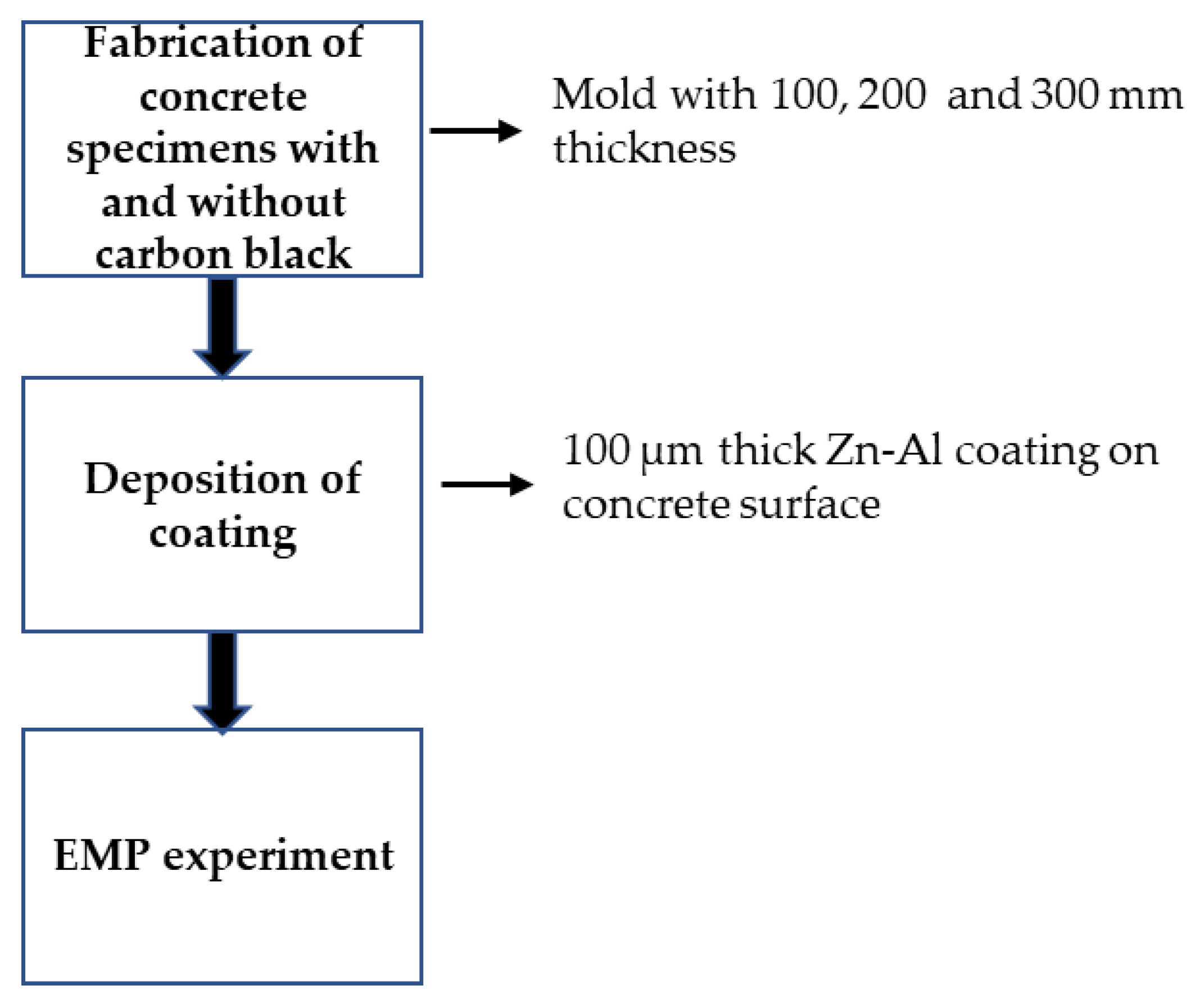
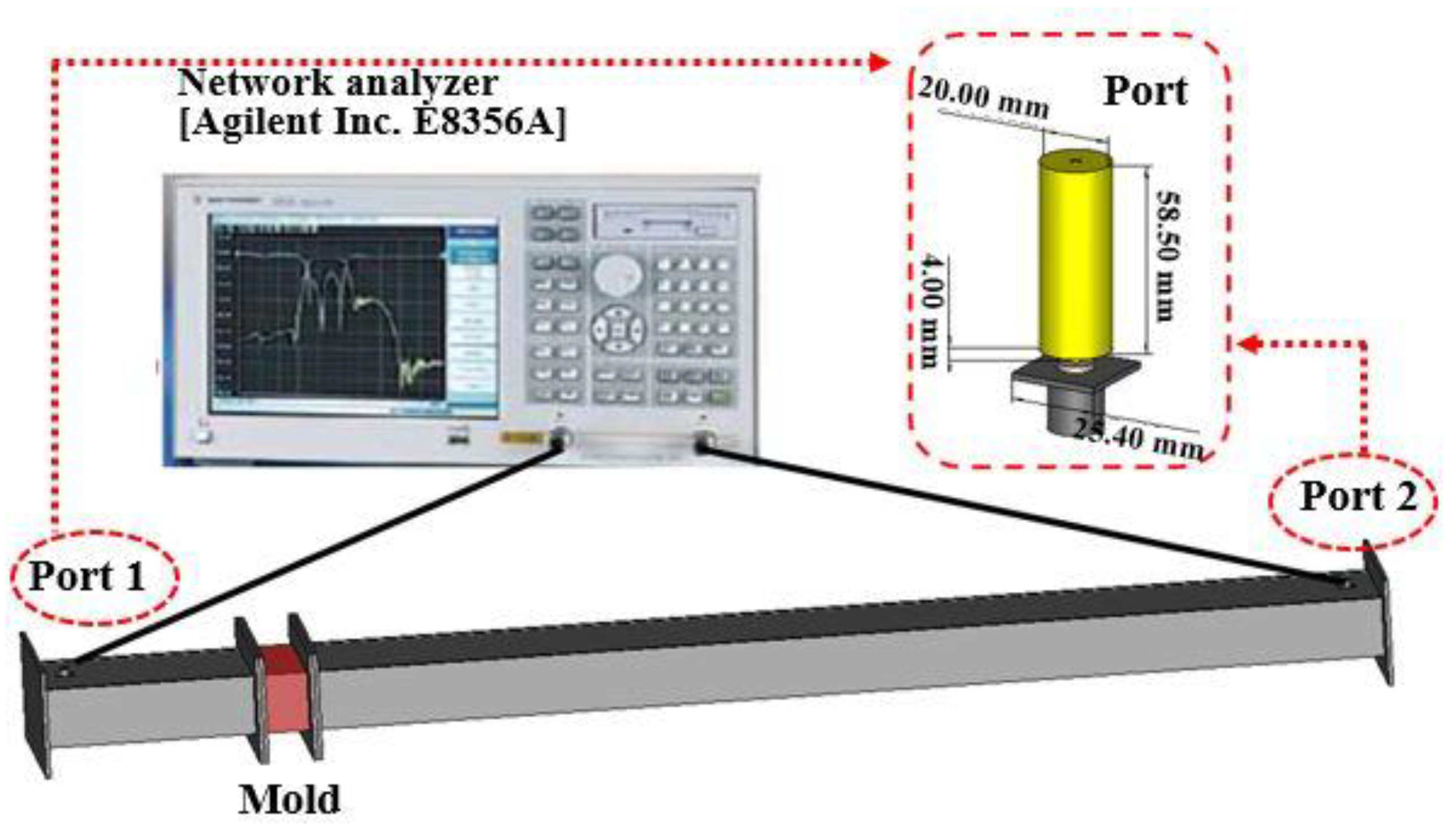

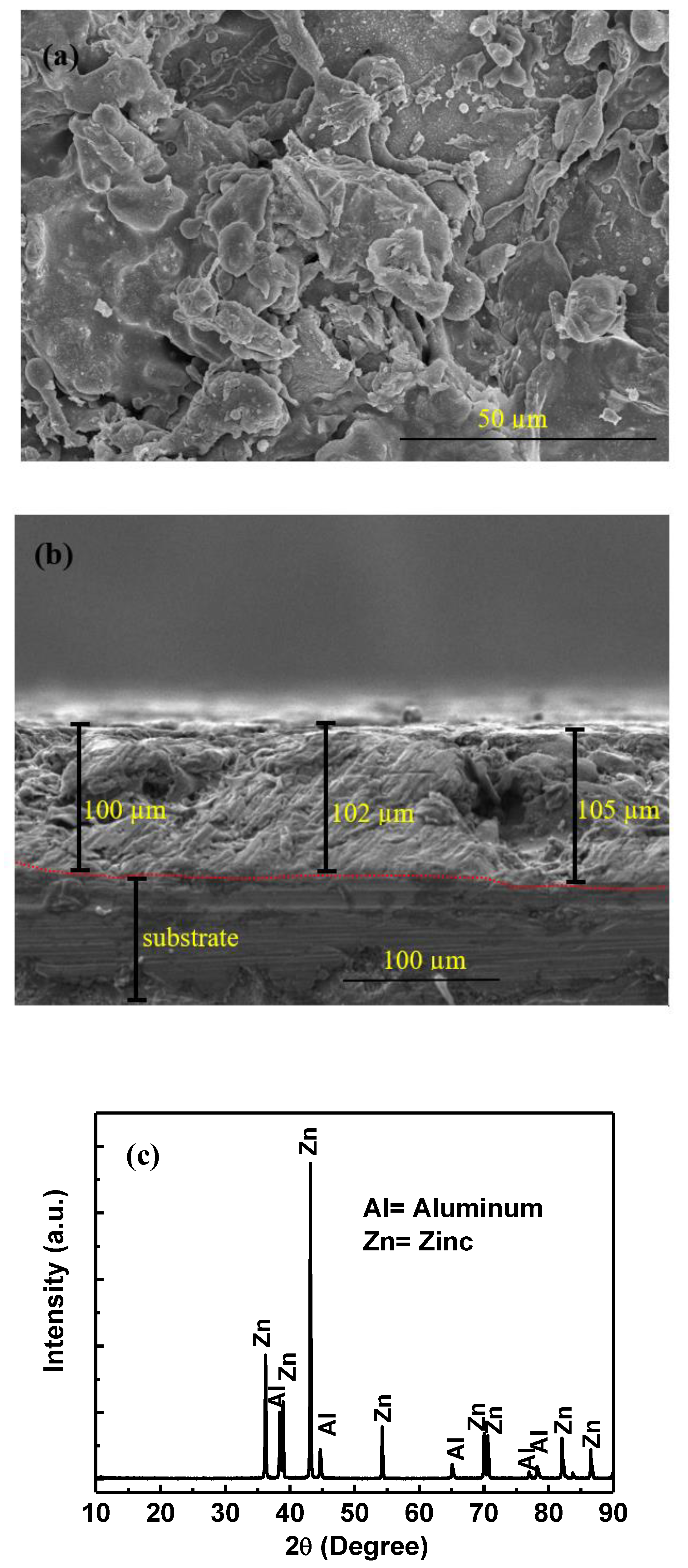
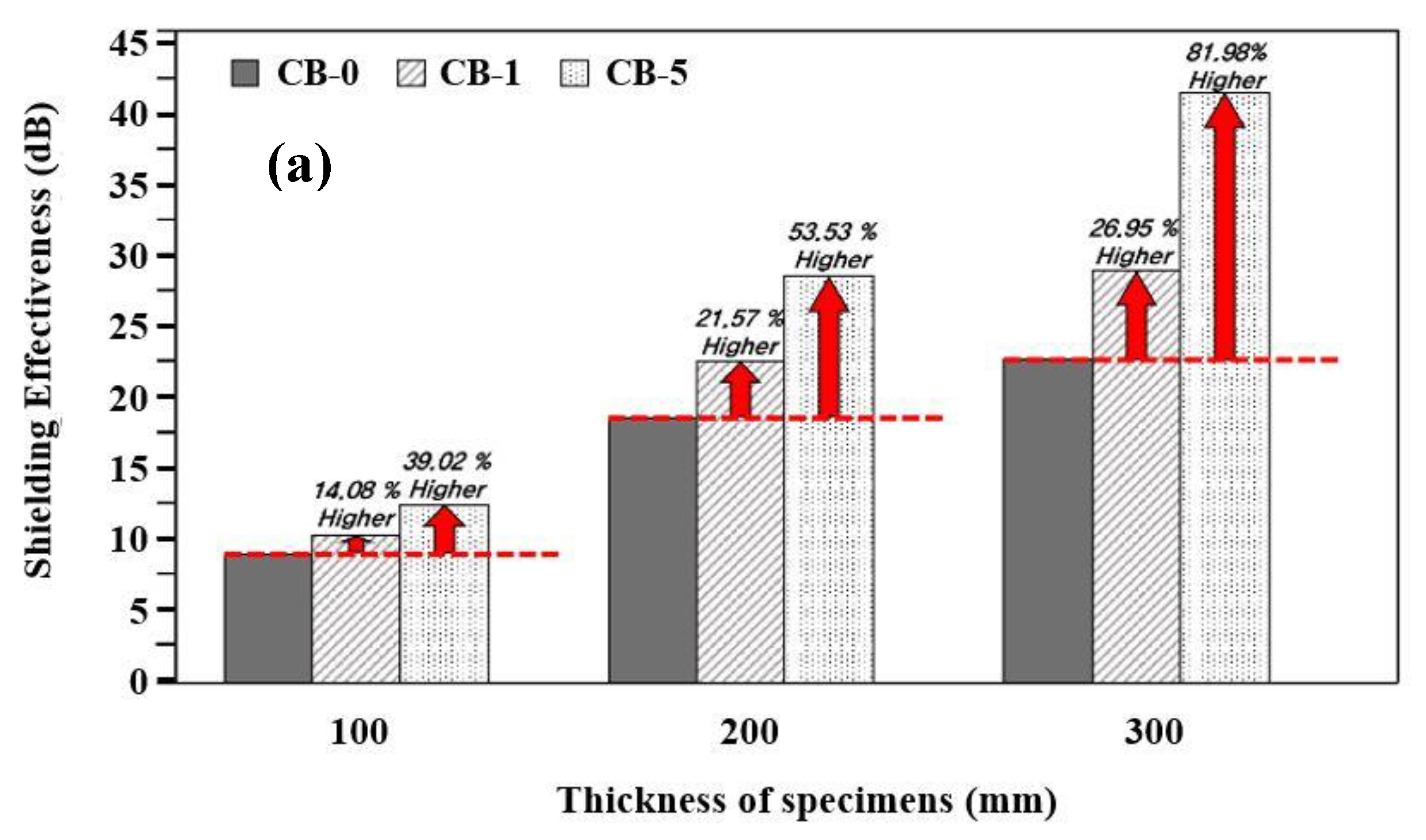
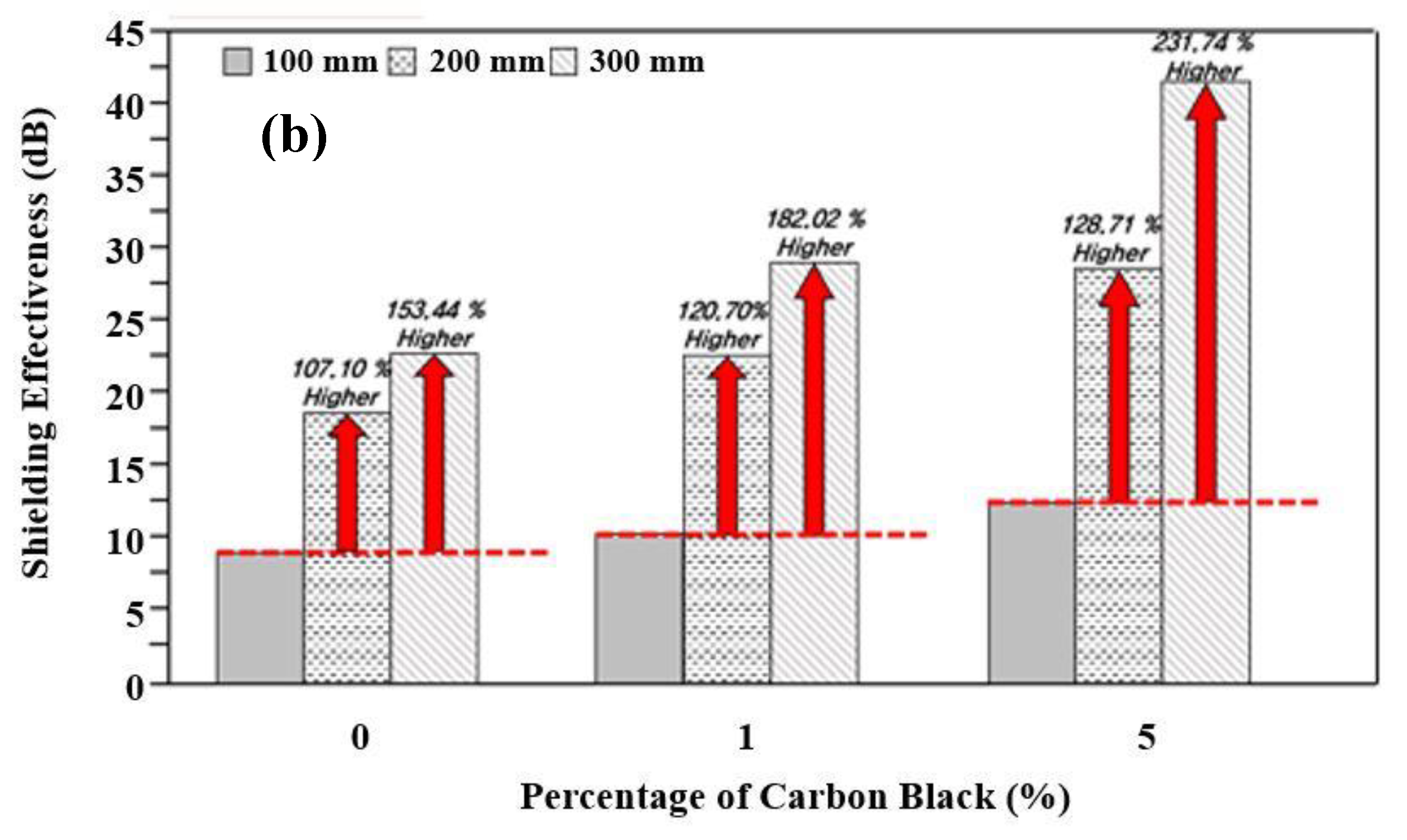

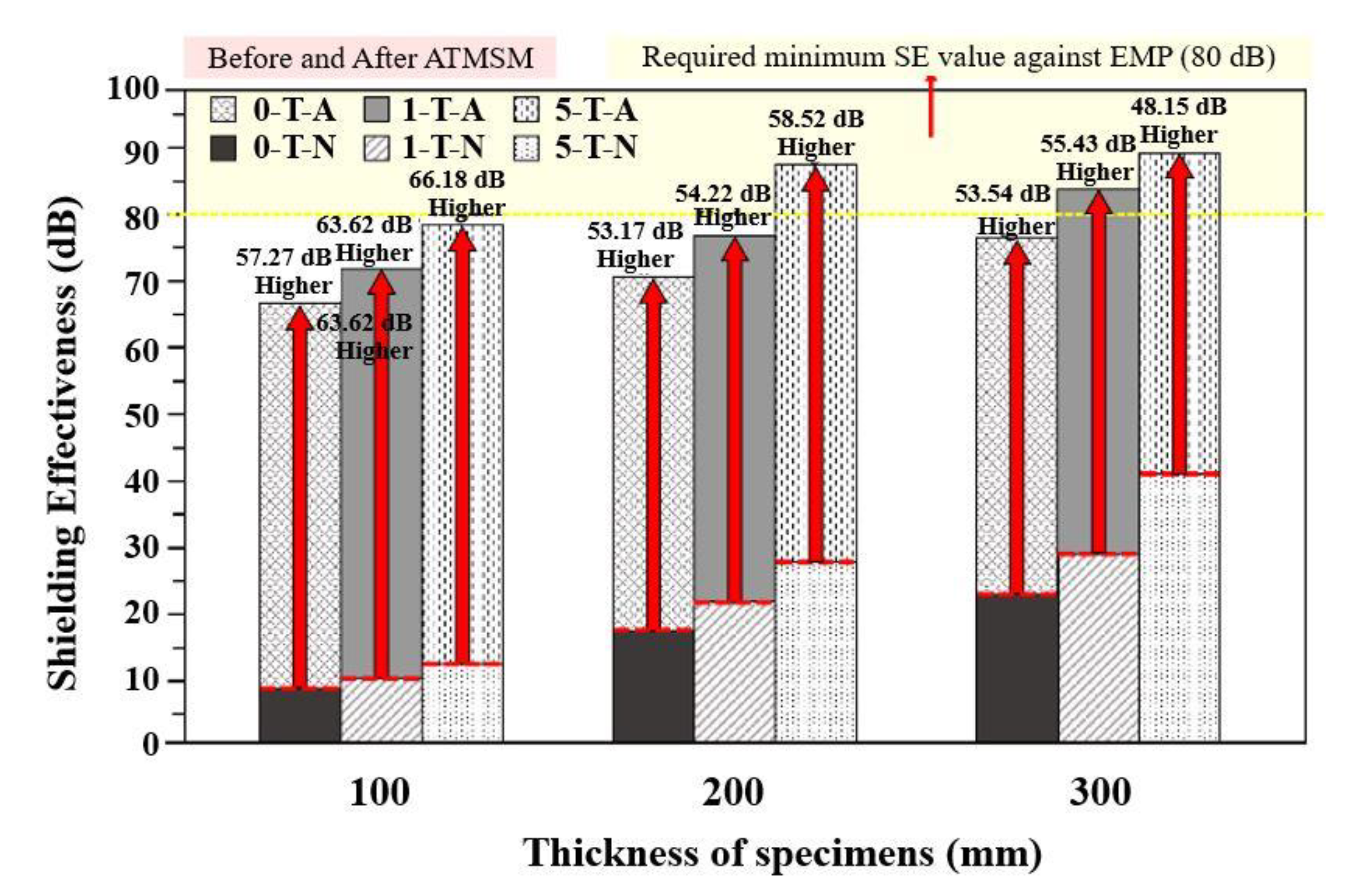

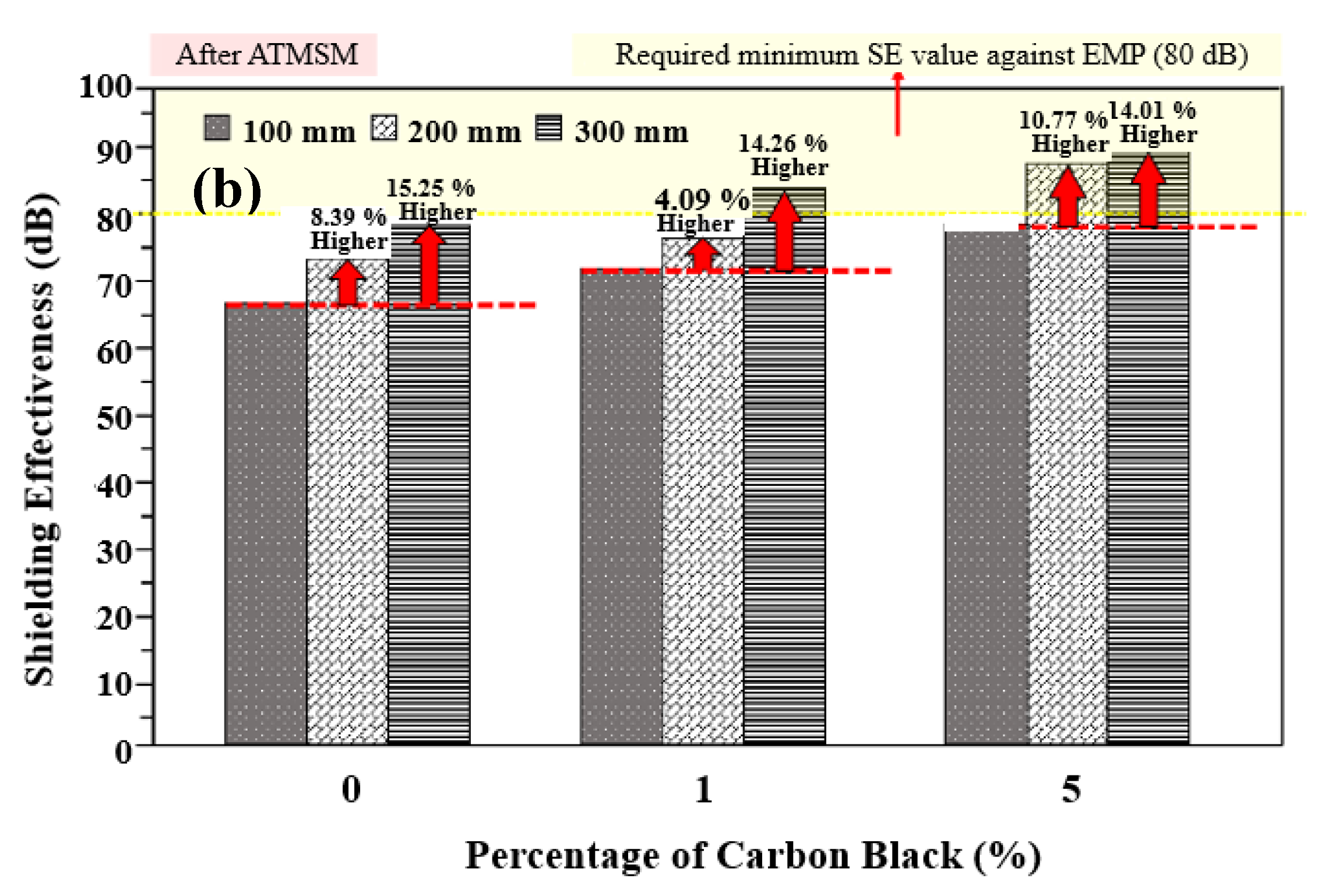

| Specimen Name | Carbon Black Content (%) | Concrete Thickness (mm) | Application of 100 µm Zn–Al Coating |
|---|---|---|---|
| 0-100-N | 0 | 100 | No |
| 0-100-A | 0 | 100 | Yes |
| 0-200-N | 0 | 200 | No |
| 0-200-A | 0 | 200 | Yes |
| 0-300-N | 0 | 300 | No |
| 0-300-A | 0 | 300 | Yes |
| 1-100-N | 1 | 100 | No |
| 1-100-A | 1 | 100 | Yes |
| 1-200-N | 1 | 200 | No |
| 1-200-A | 1 | 200 | Yes |
| 1-300-N | 1 | 300 | No |
| 1-300-A | 1 | 300 | Yes |
| 5-100-N | 5 | 100 | No |
| 5-100-A | 5 | 100 | Yes |
| 5-200-N | 5 | 200 | No |
| 5-200-A | 5 | 200 | Yes |
| 5-300-N | 5 | 300 | No |
| 5-300-A | 5 | 300 | Yes |
| % Age of Chemicals | Cement | Carbon Black |
|---|---|---|
| C | - | 99.5 |
| SiO2 | 19.47 | 0.06 |
| Al2O3 | 5.24 | 0.03 |
| MgO | 3.72 | - |
| SO3 | 2.49 | 0.31 |
| CaO | 61.8 | 0.04 |
| Fe2O3 | 2.69 | 0.04 |
| Na2O | 0.18 | - |
| K2O | 0.87 | - |
| ZnO | - | 0.02 |
| etc. | 0.94 | - |
| Loss of Ignition | 2.6 | - |
| Wt% of carbon black | 0% | 1% | 5% | |
| water/binder ratio | 0.495 | 0.495 | 0.495 | |
| Unit weight (kg/m3) | Water | 173 | 173 | 173 |
| Cement | 350 | 350 | 350 | |
| Carbon black | 0 | 4 | 18 | |
| Sand | 873 | 869 | 856 | |
| Gravel | 929 | 925 | 912 | |
| Dispersant (kg) | - | 1.2 | 5.4 | |
| Admixture (kg) | 5.25 | 5.31 | 5.52 | |
© 2020 by the authors. Licensee MDPI, Basel, Switzerland. This article is an open access article distributed under the terms and conditions of the Creative Commons Attribution (CC BY) license (http://creativecommons.org/licenses/by/4.0/).
Share and Cite
Lee, H.-S.; Park, J.-h.; Singh, J.K.; Choi, H.-J.; Mandal, S.; Jang, J.-M.; Yang, H.-M. Electromagnetic Shielding Performance of Carbon Black Mixed Concrete with Zn–Al Metal Thermal Spray Coating. Materials 2020, 13, 895. https://doi.org/10.3390/ma13040895
Lee H-S, Park J-h, Singh JK, Choi H-J, Mandal S, Jang J-M, Yang H-M. Electromagnetic Shielding Performance of Carbon Black Mixed Concrete with Zn–Al Metal Thermal Spray Coating. Materials. 2020; 13(4):895. https://doi.org/10.3390/ma13040895
Chicago/Turabian StyleLee, Han-Seung, Jin-ho Park, Jitendra Kumar Singh, Hyun-Jun Choi, Soumen Mandal, Jong-Min Jang, and Hyun-Min Yang. 2020. "Electromagnetic Shielding Performance of Carbon Black Mixed Concrete with Zn–Al Metal Thermal Spray Coating" Materials 13, no. 4: 895. https://doi.org/10.3390/ma13040895
APA StyleLee, H.-S., Park, J.-h., Singh, J. K., Choi, H.-J., Mandal, S., Jang, J.-M., & Yang, H.-M. (2020). Electromagnetic Shielding Performance of Carbon Black Mixed Concrete with Zn–Al Metal Thermal Spray Coating. Materials, 13(4), 895. https://doi.org/10.3390/ma13040895









